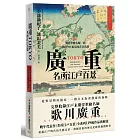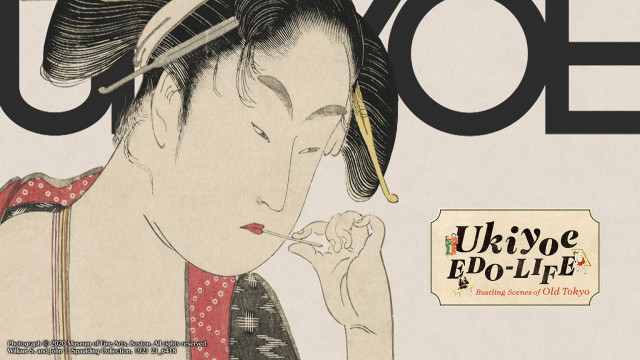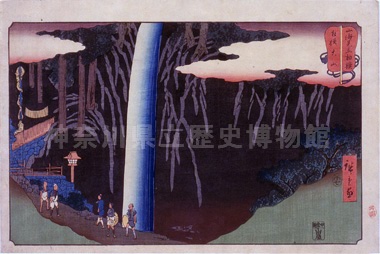The top 3 female celebrities in Edo: Tomimoto Toyohina, Takashima Ohisa and Naniwaya Kita. See how Utamaro, the master of female beauty has illustrated them so differently.
Program Outline
36 episodes
Centuries ago, Tokyo was known as Edo. More than a million people enjoyed life in this small but abundant city. They live on in ukiyo-e woodblock prints. Each episode is a deep dive into a single print, and an exploration of the soul of Old Tokyo. We examine works by artists like Hokusai and Hiroshige not just for their aesthetic and historical value, but for the stories they tell of everyday life. That is how the people of Edo themselves enjoyed this mass-produced medium.
https://www3.nhk.or.jp/nhkworld/en/ondemand/video/6030002/?fbclid=IwAR0ivpG96T6Ek13lVQ_BtA_muMpyPQK-UQewoBBdSdYs7VViiI5ked8Uvos
British Museum
Dancing until the sun comes up takes on a new meaning in this Japanese woodblock print, which tells the story of the sun goddess Amaterasu

 As goddess of the sun Amaterasu ruled over the entire celestial realm as one of the most important kami – deities in the native Shintō religion.
As goddess of the sun Amaterasu ruled over the entire celestial realm as one of the most important kami – deities in the native Shintō religion.  Her brother, the storm god Susanoo, was jealous and destroyed her fields and palaces. The grieving Amaterasu retreated to a mountain cave, plunging the world into darkness.
Her brother, the storm god Susanoo, was jealous and destroyed her fields and palaces. The grieving Amaterasu retreated to a mountain cave, plunging the world into darkness.  The other kami gathered to lure the sun goddess out. They found cockerels, whose crowing precedes the dawn, and hung a mirror in front of her cave. See if you can spot the mirror in the upper right of the print!
The other kami gathered to lure the sun goddess out. They found cockerels, whose crowing precedes the dawn, and hung a mirror in front of her cave. See if you can spot the mirror in the upper right of the print! The goddess of dance, Amenouzume, lit a bonfire and began to perform. Amenouzume can be seen holding a ‘gohei’ (a wooden wand with paper streamers) and a ‘suzu’ bell tree, both of which are still used in ‘kagura’ Shintō dances today.
The goddess of dance, Amenouzume, lit a bonfire and began to perform. Amenouzume can be seen holding a ‘gohei’ (a wooden wand with paper streamers) and a ‘suzu’ bell tree, both of which are still used in ‘kagura’ Shintō dances today. Raucous laughter from the assembled deities encouraged Amaterasu to peak out from the cave and light was thus restored to the world.
Raucous laughter from the assembled deities encouraged Amaterasu to peak out from the cave and light was thus restored to the world. This print is the work of Utagawa Hiroshige – a master of the ukiyo-e woodblock printing tradition. Throughout his long career he created a phenomenal 8000 prints, mostly subtle and soft landscapes with mist or moonlight

Hiroshige died #OnThisDay in 1858.
 Utagawa Hiroshige (1797–1858), ‘A Musical Performance by the Deities Entices the Divine Radiance’ from the series ‘Illustrated Guide to the History of Japan’. Colour woodblock print on paper, Japan, 1847–52. Read more: https://ow.ly/fwLB50PR629
Utagawa Hiroshige (1797–1858), ‘A Musical Performance by the Deities Entices the Divine Radiance’ from the series ‘Illustrated Guide to the History of Japan’. Colour woodblock print on paper, Japan, 1847–52. Read more: https://ow.ly/fwLB50PR629
501
英國博物館 3天 · 跳舞直到太陽升起在這幅日本木版畫中被賦予了新的意義,它講述了太陽女神天照的故事🌄 ☀ 身為太陽女神,天照作為本土神道教中最重要的神祇之一統治著整個天界。 🗻 她的哥哥,風暴之神須佐之男嫉妒並摧毀了她的田地和宮殿。悲傷的天照退入山洞,世界陷入黑暗。 🐓 其他神聚集在一起引誘太陽女神。他們發現了黎明前的公雞,並在她的洞穴前掛了一面鏡子。看看你是否能發現印刷品右上角的鏡子! 💃舞蹈女神天女點燃營火開始表演。可以看到雨乃手拿一根「gohei」(有紙飄帶的木杖)和一棵「suzu」鈴樹,這兩種樹至今仍在「神樂」神道舞蹈中使用。 🎉眾神喧鬧的笑聲鼓勵天照從洞穴中爬出,世界因此恢復了光明。 這幅版畫是浮世繪木刻印刷傳統大師歌川廣重的作品。在他漫長的職業生涯中,他創作了 8000 幅驚人的版畫,大部分都是帶有薄霧或月光的微妙而柔和的風景畫 🌙 廣重於 1858 年#OnThisDay 逝世。 🔎 歌川廣重(1797-1858),《日本歷史圖鑑》系列中的《神靈演奏引得神聖光輝》。紙上彩色木版畫,日本,1847-52 年。了解更多:https://ow.ly/fwLB50PR629
Musée national des arts asiatiques - Guimet
 | HIROSHIGE
| HIROSHIGE#DerniersJours

Il ne reste plus que quelques jours pour admirer les estampes pour éventails de Hiroshige, pan méconnu de l'œuvre du maître de l'estampe.
Non découpées et dans leur premier tirage, ces estampes uniques n'avaient jamais été exposées auparavant.
Une exposition réalisée avec des prêts exceptionnels de la Collection Georges Leskowicz.
"Hiroshige et l'éventail. Voyage dans le Japon du 19e siècle".
 Jusqu'au 29 mai au musée Guimet
Jusqu'au 29 mai au musée Guimet© Fundacja Jerzego Leskowicza
Musée national des arts asiatiques - Guimet
 | PLEINE LUNE
| PLEINE LUNEÀ l'image du lièvre de cette estampe, vous aussi vous pourrez admirer la pleine lune ce soir.
Le motif pictural qui associe le lièvre et la pleine lune trouve son origine dans des légendes bouddhiques indiennes diffusées au Japon. Dans cette estampe, Hiroshige supprime les lignes de contour du dessin pour n'utiliser que des aplats de couleurs, et joue sur les effets de motifs en réserve.
Une exposition réalisée avec des prêts exceptionnels de la Collection Georges Leskowicz.
"Hiroshige et l'éventail. Voyage dans le Japon du 19e siècle".
 Du 15 février au 29 mai au musée Guimet
Du 15 février au 29 mai au musée Guimet
歌川廣重(1797-1858)
nhk world
Hiroshige's struggles to become a successful ukiyo-e artist is supported by his devoted wife. Using a paint called Berlin blue, he pursues his passion for painting, but success comes at a price. Ep.3
HIROSHIGE
There are only a few days left to admire Hiroshige's prints for fans, a little-known part of the master printmaker's work. Uncut and in their first printing, these unique prints have never been exhibited before. An exhibition produced with exceptional loans from the Georges Leskowicz Collection. "Hiroshige and the Fan. Journey to 19th Century Japan". 📆 Until May 29 at the Guimet Museum © Fundacja Jerzego Leskowicza
There are only a few days left to admire Hiroshige's prints for fans, a little-known part of the master printmaker's work. Uncut and in their first printing, these unique prints have never been exhibited before. An exhibition produced with exceptional loans from the Georges Leskowicz Collection. "Hiroshige and the Fan. Journey to 19th Century Japan". 📆 Until May 29 at the Guimet Museum © Fundacja Jerzego Leskowicza

14:49
251 日本浮世繪大師--歌川廣重 (歌川広重) 漢清講堂 251
----本朝名所 薩多富士」
https://collections.mfa.org/objects/498617
Pine of Success and Oumayagashi, Asakusa River (Asakusagawa Shubi no matsu Oumayagashi), from the series One Hundred Famous Views of Edo (Meisho Edo hyakkei)
「名所江戸百景 浅草川首尾の松御厩河岸」
Japanese
Edo period
1856 (Ansei 3), 8th month
----Otori Shrine. Hiroshige. 1857.
 這幅值得與Manet 的封面
這幅值得與Manet 的封面山海見立相撲
這組我以前沒注意山海見立相撲 相模大山 - 神奈川県立歴史博物館
白居易:不堪紅葉青苔地,又是涼風暮雨天。
日本浮世繪大師--歌川廣重 Hiroshige (歌川広重)
https://hanchingchung.blogspot.com/2018/12/blog-post_10.html
日本浮世繪大師--歌川廣重 Hiroshige (歌川広重)
https://hanchingchung.blogspot.com/2018/12/blog-post_10.html
Riyazuddin Munshi發文到#1Friends Who Like Riyazuddin Munshi's Shared Art Studio
Hiroshige (1797–1858)
"The moon over a waterfall
"The moon over a waterfall
251 日本浮世繪大師--歌川廣重 (歌川広重) 漢清講堂
https://www.youtube.com/watch?v=UiE_e7iIBC8&feature=push-u-sub&attr_tag=t3ebEVMgWrwKw_UM%3A6
⛩ Dernier jour Exposition - Sur la route du Tokaido !
Comme ces voyageurs, prenez la route du Musée Guimet aujourd'hui pour découvrir les chefs-d'œuvre de la Collection Leskowicz ! 👜 C'est votre toute dernière chance pour découvrir l'exposition : elle se termine ce soir ! ⚠️ #ExpoTokaido
📆 Jusqu'à 18h !
➡️ bit.ly/expotokaido
______________________
➡️ bit.ly/expotokaido
______________________
📸 Cinquante-trois relais du Tokaido
Vue du pont Nihonbashi au petit matin (1ère vue). Détail.
Vue du pont Nihonbashi au petit matin (1ère vue). Détail.
Utagawa Hiroshige (1797-1858)
Japon, époque d’Edo, vers 1833-1834
Japon, époque d’Edo, vers 1833-1834
Editeur : Takenouchi Magohachi (Hôeidô)
Impression polychrome
nishiki-e, format oban horizontal (env. 25 x 36 cm)
Impression polychrome
nishiki-e, format oban horizontal (env. 25 x 36 cm)
Fondation Jerzy Leskowicz, collection Leskowicz
© Fondation Jerzy Leskowic
© Fondation Jerzy Leskowic
全圖 東海道五十五....
http://www.japanfm.fr/article-6461-partirsur-la-route-du-tokaidopuis-rejoindreappel-a-lactionde-mr-et-pharrell-williams.html
梵谷
辛波絲卡(Wislawa Szymborska): The People On The Bridge;一首詩/思索辛波絲卡的命運
Wisława Szymborska
5018.10.27
Utagawa Hiroshige 歌川広重 1797-1858
https://www.youtube.com/watch?v=qpDloaPywJs
5018.10.27
Utagawa Hiroshige 歌川広重 1797-1858
https://www.youtube.com/watch?v=qpDloaPywJs
503. The People On The Bridge - Wislawa Szymborska (1)
(Hiroshige Utagawa: "The Landscape")

Translated from the Polish by Stanislaw Baranczak and Clare Cavanagh
An odd planet, and those on it are odd, too.
They're subject to time, but they won't admit it.
They have their own ways of expressing protest.
They make up little pictures, like for instance this:
At first glance, nothing special.
What you see is water.
And one of its banks.
And a little boat sailing strenuously upstream.
And a bridge over the water, and people on the bridge.
It appears that the people are picking up their pace
because of the rain just beginning to lash down
from a dark cloud.
The thing is, nothing else happens.
The cloud doesn't change its color or its shape.
The rain doesn't increase or subside.
The boat sails on without moving.
The people on the bridge are running now
exactly where they ran before.
It's difficult at this point to keep from commenting.
This picture is by no means innocent.
Time has been stopped here.
Its laws are no longer consulted.
It has been relieved of its influence over the course of events.
It has been ignored and insulted.
On account of a rebel,
one Hiroshige Utagawa
(a being who, by the way,
died long ago and in due course),
time has tripped and fallen down.
It might well be simply a trifling prank,
an antic on the scale of just a couple of galaxies,
let us, however, just in case,
add one final comment for the record:
For generations, it's been considered good form here
to think highly of this picture,
to be entranced and moved.
There are those for whom even this is not enough.
They go so far as to hear the rain's spatter,
to feel the cold drops on their necks and backs,
they look at the bridge and the people on it
as if they saw themselves there,
running the same never-to-be-finished race
through the same endless, ever-to-be-covered distance,
and they have the nerve to believe
that this is really so.

Translated from the Polish by Stanislaw Baranczak and Clare Cavanagh
An odd planet, and those on it are odd, too.
They're subject to time, but they won't admit it.
They have their own ways of expressing protest.
They make up little pictures, like for instance this:
At first glance, nothing special.
What you see is water.
And one of its banks.
And a little boat sailing strenuously upstream.
And a bridge over the water, and people on the bridge.
It appears that the people are picking up their pace
because of the rain just beginning to lash down
from a dark cloud.
The thing is, nothing else happens.
The cloud doesn't change its color or its shape.
The rain doesn't increase or subside.
The boat sails on without moving.
The people on the bridge are running now
exactly where they ran before.
It's difficult at this point to keep from commenting.
This picture is by no means innocent.
Time has been stopped here.
Its laws are no longer consulted.
It has been relieved of its influence over the course of events.
It has been ignored and insulted.
On account of a rebel,
one Hiroshige Utagawa
(a being who, by the way,
died long ago and in due course),
time has tripped and fallen down.
It might well be simply a trifling prank,
an antic on the scale of just a couple of galaxies,
let us, however, just in case,
add one final comment for the record:
For generations, it's been considered good form here
to think highly of this picture,
to be entranced and moved.
There are those for whom even this is not enough.
They go so far as to hear the rain's spatter,
to feel the cold drops on their necks and backs,
they look at the bridge and the people on it
as if they saw themselves there,
running the same never-to-be-finished race
through the same endless, ever-to-be-covered distance,
and they have the nerve to believe
that this is really so.
Utagawa Hiroshige (1797-1858)
Edo period (1615-1868), 1857
An oban tate-e print
Private collection
Edo period (1615-1868), 1857
An oban tate-e print
Private collection
iyazuddin Munshi發文到#1Friends Who Like Riyazuddin Munshi's Shared Art Studio
Hiroshige (1797–1858)
"The moon over a waterfall
"The moon over a waterfall
[Haïku]
Brume et pluie
Fuji caché. Mais cependant je vais
Content.
Fuji caché. Mais cependant je vais
Content.
霧しぐれ
富士を見ぬ日ぞ
面白き
富士を見ぬ日ぞ
面白き
- Matsuo Bashō (1644-1695)
Un haïku pour accompagner la vue de Shono, station de la route du Tokaido où s'abat le mauvais temps, et pour braver le vent et la baisse des températures en ce début de semaine. Bon lundi à tous ! 🎐
▬▬▬▬▬▬▬▬▬▬▬▬▬▬▬▬▬▬▬▬▬▬▬▬▬▬▬
Cinquante-trois relais du Tokaido
Shono, Pluie d'orage (46e vue)
Shono, Pluie d'orage (46e vue)
Utagawa Hiroshige (1797-1858)
Japon, époque d’Edo, vers 1833-1834
Japon, époque d’Edo, vers 1833-1834
Editeur : Takenouchi Magohachi (Hôeidô)
Impression polychrome nishiki-e, format oban horizontal (env. 25 x 36 cm)
Impression polychrome nishiki-e, format oban horizontal (env. 25 x 36 cm)
Fondation Jerzy Leskowicz, collection Leskowicz
© Fondation Jerzy Leskowic
© Fondation Jerzy Leskowic
Everyone’s talking about the #Superbowl today, so here’s a superb owl from the collection! 🦉🏈
This sleepy owl was made in the 19th century by Japanese artist Utagawa Hiroshige. The inscription is a haiku written in cursive script, which roughly translates as:
‘The old maple
looks rosy and refreshed
from end to end.’
Hiroshige designed at least two prints with anwl taking a nap, so it seems to have been a popular theme http://ow.ly/A2vt30nvCNl
This sleepy owl was made in the 19th century by Japanese artist Utagawa Hiroshige. The inscription is a haiku written in cursive script, which roughly translates as:
‘The old maple
looks rosy and refreshed
from end to end.’
Hiroshige designed at least two prints with anwl taking a nap, so it seems to have been a popular theme http://ow.ly/A2vt30nvCNl

廣重 Tokyo 名所江戶百景
廣重TOKYO 名所江戶百景:與浮世繪大師一同尋訪今日東京的昔日名勝
広重TOKYO 名所江戸百景
分享對象:公開
湯島聖堂;昌平橋聖堂神田川 廣重 名所江戸百図1857;胡適海外買書記 湯島聖堂 1953;漢寶德 東京孔廟 198?
作者介紹
目錄
Considered the last great master of the ukiyo-e genre (“pictures of the floating world”), the Japanese artist Utagawa Hiroshige (1797–1858) was a hugely influential figure, not only in his homeland but also on Western painting.
Towards the end of the nineteenth century, as a part of the trend in “Japonism”, European artists such as Monet, Whistler, and Cézanne, looked to Hiroshige’s work for inspiration, and a certain Vincent van Gogh was known to paint copies of his prints.
Hiroshige was born in 1797 to a samurai family in Edo (modern Tokyo).
After his parents died, around the age of fourteen, Hiroshige began to take up painting and studied for several years under the artist Toyohiro. During this period he produced many works reflecting traditional ukiyo-e themes such as women and actors, but upon Toyohiro’s death in 1928 he underwent a pronounced shift toward the landscapes for which he is best known today, as well as bird and flower images. His most famous series include Famous Views of the Eastern Capital (1831), The Fifty-three Stations of the Tōkaidō (1833–1834), The Sixty-nine Stations of the Kisokaidō (1834–1842) and Thirty-six Views of Mount Fuji (1852–1858).
In 1856, around the age of 60, Hiroshige “retired from the world”, becoming a Buddhist monk. Two years later he passed away (during the great Edo cholera epidemic, though it’s not known if this was the cause of death) and was buried in a Zen temple in Asakusa. Just before his passing, he wrote the following poem:
I leave my brush in the East
And set forth on my journey.
I shall see the famous places in the Western Land.
And set forth on my journey.
I shall see the famous places in the Western Land.









沒有留言:
張貼留言